ACCIDENTS happen in car racing and some of the scariest are those involving fire. Fire can not only destroy a car in a matter of seconds, it can cause injury and even death. Of course, prevention is the best cure, which means setting your car up right and keeping it well-maintained is paramount.
This article was originally published in the May 2015 issue of Street Machine magazine
Even so, accidents happen, which is why tracks have fire crews on duty at all times. If you want to be really sure, though, fit a fire-suppression system to your ride. This is essentially a bottle (or two) mounted in the car, that can be activated by hitting a button or pulling a lever. It will then cover you and your engine in fire-suppressing agent.
Video: Why do burnout cars catch fire?
In some classes of drag racing, such a system is mandatory under ANDRA rules, including for any enclosed vehicle that runs quicker than eight seconds over the quarter. The systems must be SFI-certified and re-filled every two years. They are also mandatory at over 200mph for DLRA cars, and are starting to find their way into burnout and drift cars, too.
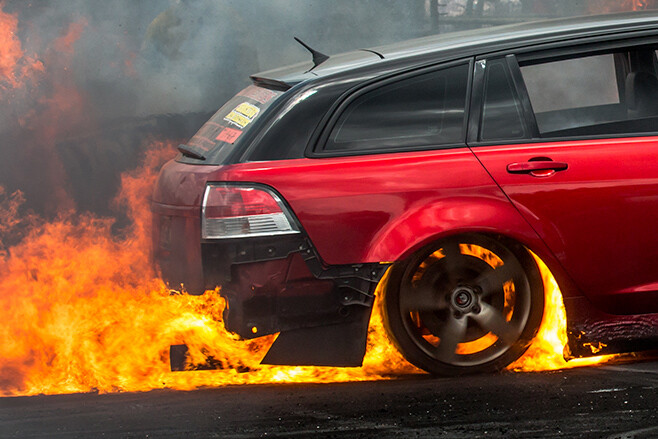 To see what is involved in fitting a system we tagged along with Rob from South Pine Speed Shop in Queensland, as they installed one of Motorsport Connections’ DJ Safety Cold Fire systems into Rob’s new FX Holden gasser. “It kills the fire on contact by making a vapour seal over the fuel, taking the heat out of the fire and helping to prevent re-ignition preventing re-ignition,” Rob says.
To see what is involved in fitting a system we tagged along with Rob from South Pine Speed Shop in Queensland, as they installed one of Motorsport Connections’ DJ Safety Cold Fire systems into Rob’s new FX Holden gasser. “It kills the fire on contact by making a vapour seal over the fuel, taking the heat out of the fire and helping to prevent re-ignition preventing re-ignition,” Rob says.
Cold Fire claims that the liquid in its extinguishers is non-toxic and non-corrosive, which is good news, as some dry chemical systems can leave residue that can be corrosive and painful to clean up. Watching the South Pine guys empty bottles for recharging, we can confirm clean-up looks very easy and that it doesn’t appear to stain parts or clothes.
Video flashback: World’s biggest burnout fire
There are other SFI-approved systems that are worth checking out too, including Stroud (available from Rocket Industries), which uses a gas, rather than liquid or foam.
Rob’s system consists of a 10lb (or 300ci) bottle, with three nozzles – two out of the firewall for each bank of the engine and one coming out of the dash straight onto the driver. The system is activated by a push-button or lever, with two safety pins that need to be removed before each run – one at the bottle and one on the button or cable knob. When the button is hit it ruptures a burst disc in the head, releasing the pressurised solution.
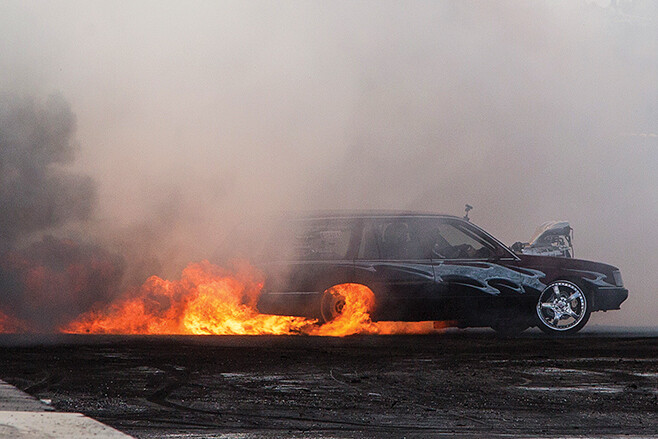 For lines, you can use either alloy hard lines or Teflon-lined stainless-steel braided lines. Which you choose is down to preference; hard lines are cheaper, but you’ll need a double-flaring tool and a tube bender to get the job done. The system can also be operated by solenoid. As a fail-safe, the system is set up as a circuit, so if one line is crushed, the other still works.
For lines, you can use either alloy hard lines or Teflon-lined stainless-steel braided lines. Which you choose is down to preference; hard lines are cheaper, but you’ll need a double-flaring tool and a tube bender to get the job done. The system can also be operated by solenoid. As a fail-safe, the system is set up as a circuit, so if one line is crushed, the other still works.
FITTING AN ON-BOARD FIRE SYSTEM STEP-BY-STEP:
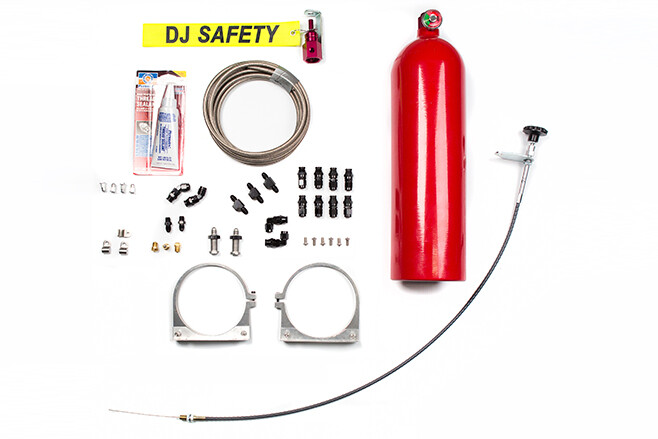 1. There are a variety of kits to suit whatever application you need, from Super Sedan right through to Top Fuel, as well as boats, burnout cars and circuit racers. You’ll need to supply your own lines, either alloy hard lines or Telfon-lined stainless-steel braided
1. There are a variety of kits to suit whatever application you need, from Super Sedan right through to Top Fuel, as well as boats, burnout cars and circuit racers. You’ll need to supply your own lines, either alloy hard lines or Telfon-lined stainless-steel braided
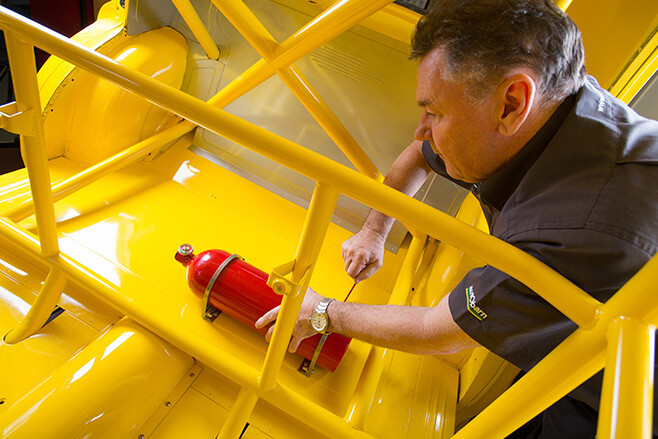 2. To ensure the system can work as efficiently as possible, it’s best to install the bottle lying on its side. Sitting it up is also allowable, but not preferred, while mounting bottles upside-down is banned under ANDRA guidelines. While some chassis-builders make their own bottle brackets into the car, we chose to use DJ’s optional 3/8in aluminium brackets, attaching them to the floor with nutserts or nylocs
2. To ensure the system can work as efficiently as possible, it’s best to install the bottle lying on its side. Sitting it up is also allowable, but not preferred, while mounting bottles upside-down is banned under ANDRA guidelines. While some chassis-builders make their own bottle brackets into the car, we chose to use DJ’s optional 3/8in aluminium brackets, attaching them to the floor with nutserts or nylocs
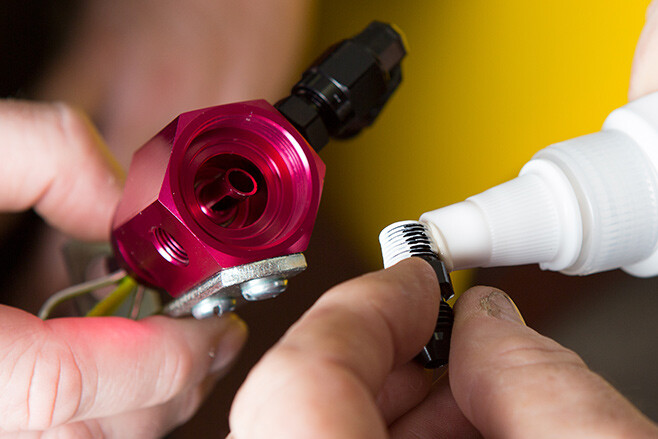 3. The injector head is O-ringed and threaded and screws onto the bottle. Two NPT fittings are screwed into the head, using Permatex high-performance thread sealant for good measure. The bracket shown is for the cable
3. The injector head is O-ringed and threaded and screws onto the bottle. Two NPT fittings are screwed into the head, using Permatex high-performance thread sealant for good measure. The bracket shown is for the cable
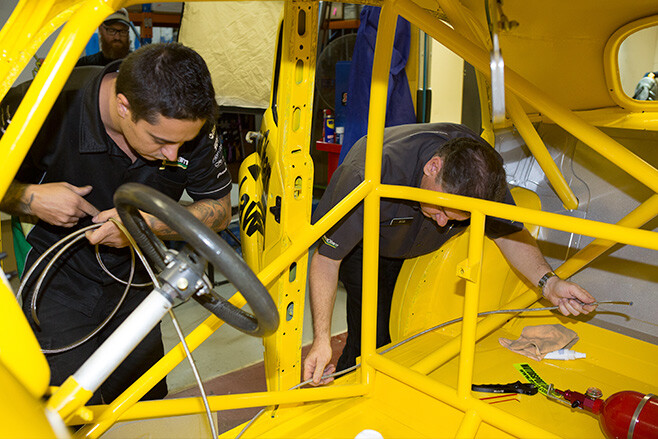 4. From here, we trial-fitted the lines, then cut them to length and fitted them to the hose-end fittings
4. From here, we trial-fitted the lines, then cut them to length and fitted them to the hose-end fittings
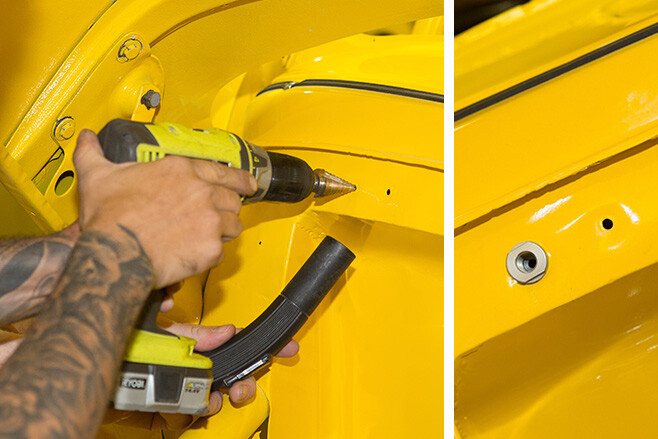 5. We wanted two discharge nozzles for the engine bay, so holes were drilled on either side of the firewall. The nozzles are of a cone-style that produces a fountain-type spray to cover as much area as possible
5. We wanted two discharge nozzles for the engine bay, so holes were drilled on either side of the firewall. The nozzles are of a cone-style that produces a fountain-type spray to cover as much area as possible
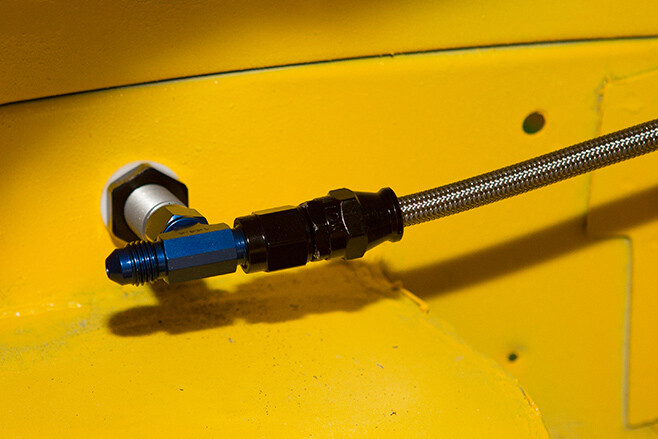 6. The nozzle is held in by a nut on the other side of the firewall and connects to a T-piece. The system runs in a circuit, so that if one line is crimped or crushed, the other will still operate as planned
6. The nozzle is held in by a nut on the other side of the firewall and connects to a T-piece. The system runs in a circuit, so that if one line is crimped or crushed, the other will still operate as planned
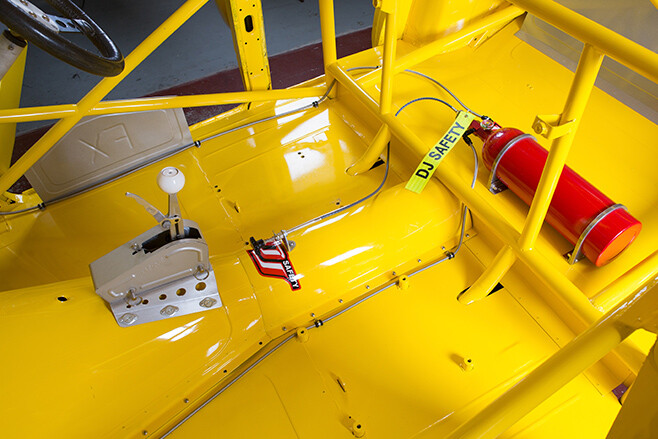 7. The cable that runs from the knob to the injector head comes in 3ft, 6ft or 9ft lengths. Some set-ups, such as funny cars – where the bottle is likely to be mounted a long way from the driver – will require a long cable, but we only needed the 3ft cable
7. The cable that runs from the knob to the injector head comes in 3ft, 6ft or 9ft lengths. Some set-ups, such as funny cars – where the bottle is likely to be mounted a long way from the driver – will require a long cable, but we only needed the 3ft cable
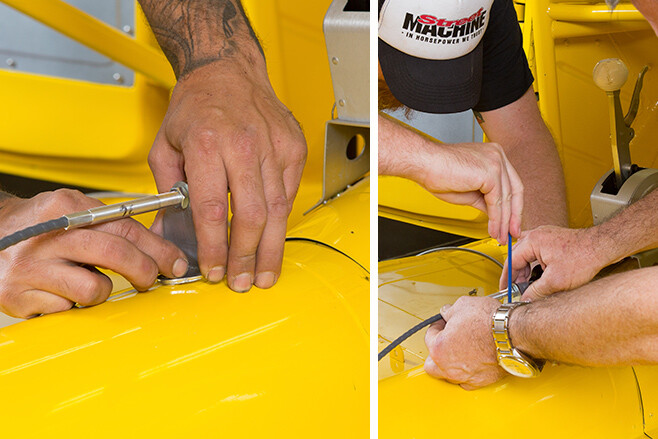 8. Again, the brackets for the button are nutserted straight into the floor. The cable connects to the bottle by loosening off an Allen key at the inlet, inserting the cable, and then tightening the Allen key again
8. Again, the brackets for the button are nutserted straight into the floor. The cable connects to the bottle by loosening off an Allen key at the inlet, inserting the cable, and then tightening the Allen key again
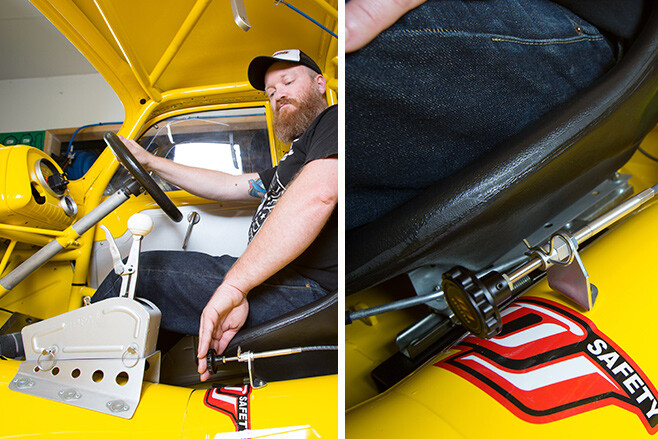 9. With the safety pins in, there is no danger of setting the system off by accident. Even so, when the pins are out, it needs a firm whack to operate
9. With the safety pins in, there is no danger of setting the system off by accident. Even so, when the pins are out, it needs a firm whack to operate
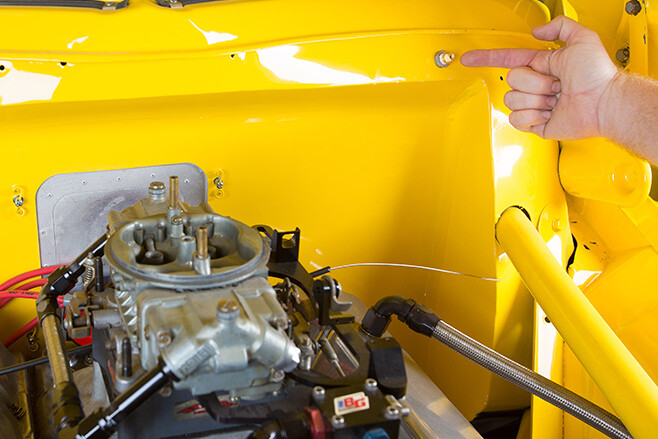 10. Lots of time and love has gone into the FX’s methanol-drinking small-block Chev – and detailing the engine bay – so it is good to know that it will be well-protected in the event of a fire
10. Lots of time and love has gone into the FX’s methanol-drinking small-block Chev – and detailing the engine bay – so it is good to know that it will be well-protected in the event of a fire
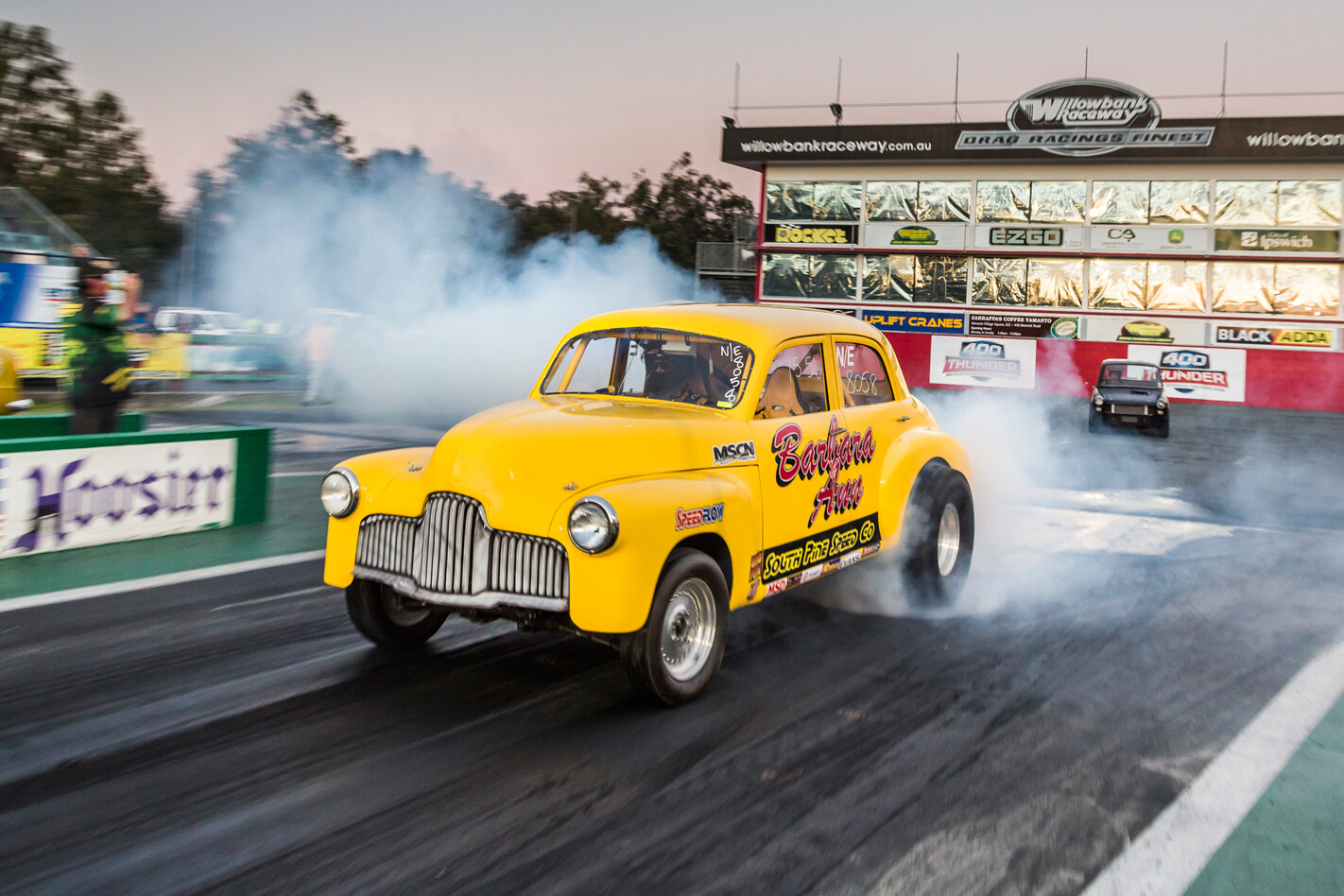 11. Now we can go out and race! Refilling and SFI certification is required by ANDRA rules every two years and can only be performed by an appropriate agent. A small price to pay for piece of mind
11. Now we can go out and race! Refilling and SFI certification is required by ANDRA rules every two years and can only be performed by an appropriate agent. A small price to pay for piece of mind
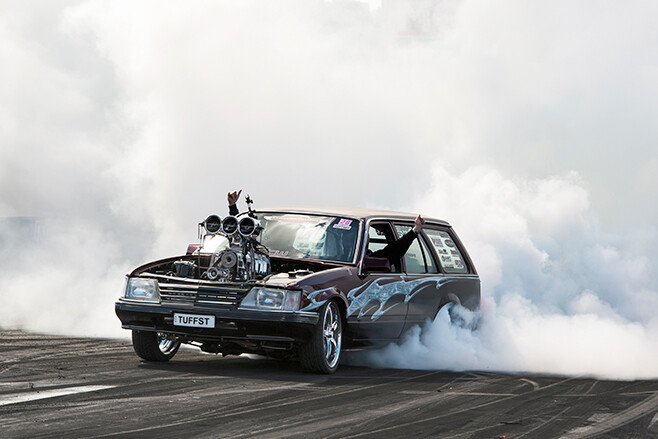 Burnout master Phil Kerjean is a big fan of the Cold Fire system – he’s got two bottles in his blown VK wagon. “There’s one system for the engine, with two nozzles facing back and one facing forward, and then I’ve got another system under the back end. It costs about $160 to refill each bottle, which is much cheaper than replacing wiring and paint.”
Burnout master Phil Kerjean is a big fan of the Cold Fire system – he’s got two bottles in his blown VK wagon. “There’s one system for the engine, with two nozzles facing back and one facing forward, and then I’ve got another system under the back end. It costs about $160 to refill each bottle, which is much cheaper than replacing wiring and paint.”
“I’ve used each system once; I used the back system at Summernats, and I used the front system at Xtreme Powerfest. If you catch it and hit the bottles early enough, it can save you damaging a lot of stuff.”
Phil reckons the best bit is that the Cold Fire retardant isn’t harmful to the car or the person inside. “Some of the stuff the fire crews use eats the paint and aluminium, and it’s not too good to breathe. Sometimes it causes more damage than the fire, but this stuff is like detergent and it just washes off afterwards.”
Being handy with the flaring and bending tools, Phil installed the kits himself and he has done a few now. He reckons the average kit is about $1000 and he charges about $400-500 to install a system, depending on its complexity.
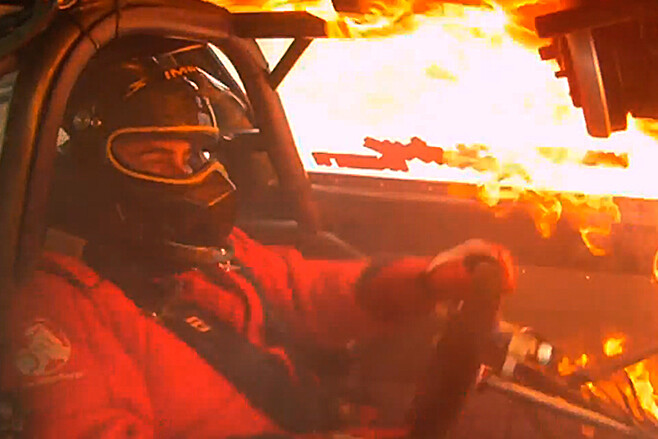 Maurice Fabietti used his Cold Fire system to good effect in 2010. His Doorslammer broke a rod, filling the engine nappy with oil. When he pulled the chute, oil went over the front of the car and it went up in flames, including inside the cabin. Maurice pulled the lever and the video shows the flames being extinguished and agent immediately covering his suit, seat and door panels. “It puts out the flames instantly,” Fab says. “And it cleans up no problem. I haven’t had to use it since, but it is good to know it is there.”
Maurice Fabietti used his Cold Fire system to good effect in 2010. His Doorslammer broke a rod, filling the engine nappy with oil. When he pulled the chute, oil went over the front of the car and it went up in flames, including inside the cabin. Maurice pulled the lever and the video shows the flames being extinguished and agent immediately covering his suit, seat and door panels. “It puts out the flames instantly,” Fab says. “And it cleans up no problem. I haven’t had to use it since, but it is good to know it is there.”
For more info, drop the South Pine Speed Shop guys a line on 0408 000 306

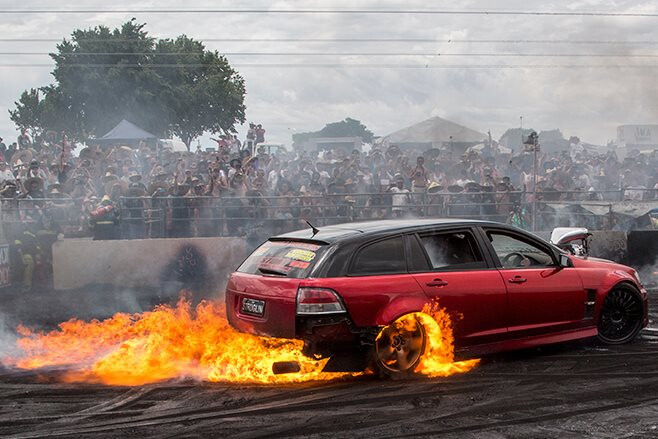
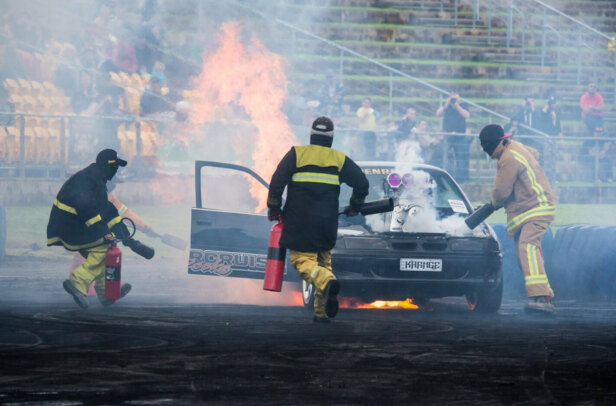
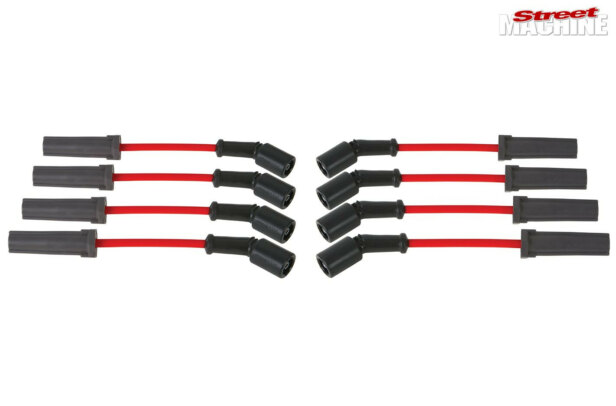
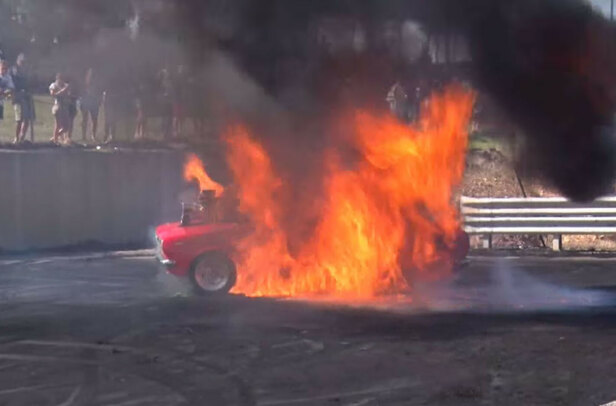
Comments